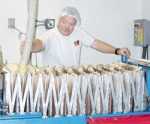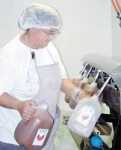Cider time: Diebold's puts the squeeze on fall fruit

BENTON -- Making 12,000 gallons of apple cider a year is a process that involves a little more than picking apples and crushing them.
Just ask Diebold's Orchard owner David Diebold.
Since 1978 Diebold and his family have consistently supplied the area with freshly made apple cider -- a process that if done wrong, can leave a bad aftertaste, or even worse, get someone sick.
That's why, Diebold said, the right blend of apples and the proper safety measures must be taken to ensure a perfect batch of cider is made.
Diebold said a perfect blend of sweet and sour apples are used in the process.

"We're very careful about the flavor," Diebold said. "We just pay attention to the flavor -- and there's no secret to that."
According to Diebold, it takes 140 bushels of apples to make 560 gallons of cider. And close to 300 gallons of cider are produced an hour.
Located in the very back of the store's building, the cider-making process occurs about once or twice a week during the fall. Then a three-person team from Diebold's Orchard spends the day making the cider.
After apples are picked from the orchard, they are stored in large plastic crates and dumped into a machine that washes and sanitizes the apples with chlorine to kill any bacteria off the fruit. Bad apples are removed by employee Will Robertson who facilitates the sanitization.
Once sanitized, the apples move through a window into the cider room and are elevated by a conveyor belt into a tank for crushing. The cider room is where the cider is actually made. Anything that comes into the cider room door has been sanitized at least once.
The apples are then ground and pumped into a machine called the press, which looks like a giant accordion and is monitored and operated by employee Harry Schumer. One side contains crushed apples to be squeezed for juice, which falls into a stainless steel tub. Once the apples are pressed by the about 1,200 pounds of pressure, the remains are dumped into a crate and used as organic matter on the orchard, Schumer said.
When the tub is full of juice, Schumer flips a switch, and the juice moves through clear piping to a prepasteurization holding tank located on a loft in the corner of the cider room.
When it reaches the required temperature, the juice then moves on to the pasteurization machine, also located in the loft, to kill any harmful bacteria. The process, which is similar to that used for milk, involves heating the freshly pressed cider for a few seconds to kill the bacteria.
During pasteurization, the juice goes through the heat exchanger, which is a component that pasteurizes the juice by bringing it to the right temperature. "The machine cannot put out unpasteurized cider," Diebold assured, adding for safety measures, records are kept on every batch of cider made.
Once pasteurized, the cider is immediately cooled.
"The pectin in cider will precipitate out if it is too hot, and that changes chemistry of the juice. Then it's processed apple juice instead of juice right out of the apple," Diebold explained.
The cider, which has been cooling in a refrigerator, is then ready to be bottled for sale. The cider fills into two stainless steel containers. When ready, the cider is siphoned into four bottles at a time by employees Leona King and Robertson. The cider is sealed, packed in large plastic bins and ready for sale. Cider is bottled both with and without preservatives and are labeled accordingly, Diebold noted. Typically cider without preservatives is good for 40 days in refrigeration, and cider with preservatives will last about five months. Seventy-five percent of the cider made at Diebold's Orchard is made with preservatives, Diebold noted.
"And you cannot tell the difference in the two," Diebold said.
No other additives are used in making cider, although when making cherry cider, a cherry flavor is added, Diebold said.
The cider-making equipment and process is state and federal inspected once a year, Diebold said, adding officials are always very satisfied with the process.
Today approximately 98 percent of Diebold's cider is distributed in Scott and Cape counties, Diebold said. And a majority of those residents can't believe how great the cider taste, he noted.
After all, there's nothing like drinking a fresh batch of apple cider.
Diebold said: "If you've have ever tasted it, there's no comparison."

